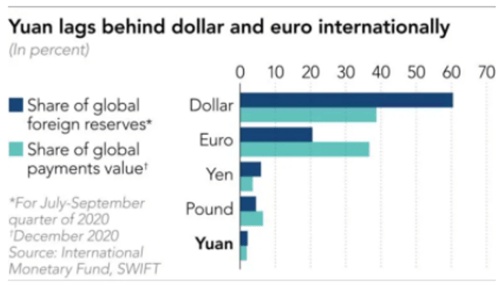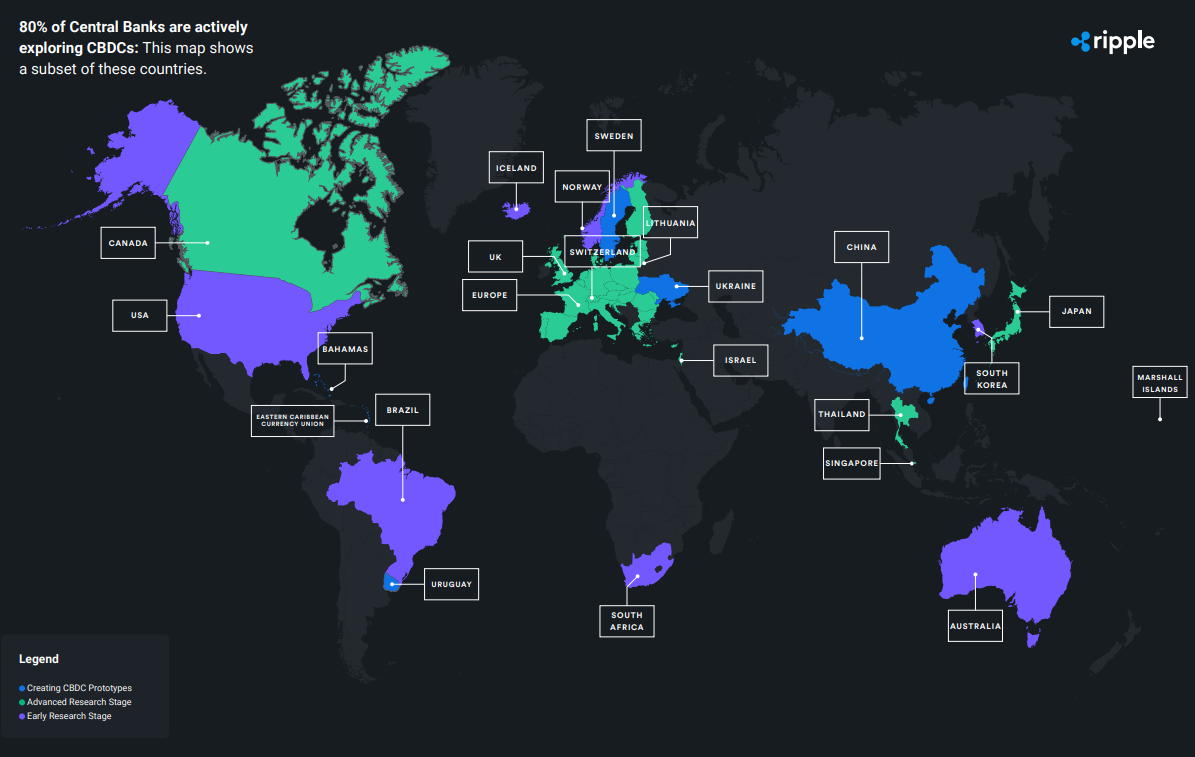The current payment system is plagued with issues: slow processing; unfavorable storing needs; ambiguous traceability; high fees; and fraud. Cryptos solve such problems, and potentially offer more market efficiency, but implementation is complex…
Key Takeaways:
- State backed cryptos are less libertarian than fully decentralized cryptos but share similarities in ledger protocols.
- Pros of a state back crypto include increased control and security, cons include major financial fabric disruptions.
- China’s Ant v. Tencent duopoly competes with e-yuan’s success, but China remains the front runner in building a state-backed currency.
- The US is behind in building their own crypto dollar, but awareness is building up especially after Bitcoin rise. E-Yuan success would accelerate crypto dollar birth.
- The Swiss Helvetia project was successful in experimenting with a crypto platform settlement system but believe more work s needed before safely implementing a CBDC.
What does it mean for governments to adopt crypto?
Treasury departments and central banks manage large quantities of money every day. By money we mean fiat currency such as everyday bills and coins, and the digits in your deposit accounts. They are legal tender and represent the very fabric of our financial system. A government backed crypto means a cryptocurrency, a digital form of that fiat money, that exists on a blockchain ledger. By ‘’sponsored’’ it means that you can give me physical money now, and I can send you the cash equivalent in the stated-backed crypto. The transaction can happen instantly and done with or without internet access.
While bitcoin and state-sponsored cryptos share similarities like anonymous transactions, publicly viewable ledgers, and instantaneous transactions, there are notable differences. The central bank would get to control the supply contained on the ledger (whereas Bitcoin has a set supply). Miners would be replaced by regulated organizations and the ledger’s voting rights and protocol would not be public but controlled by authorities. State-backed cryptos are different philosophically speaking to the more libertarian approach of decentralized crypto currencies like Cardano’s ADA protocol, or Bitcoin.

What are the pros and cons of governments adopting crypto?
The ecosystem for a state-sponsored cryptocurrency has four players: the central bank; financial institutions; end-users; and exchanges. Central banks control monetary policy and govern protocol rules. Banks are custodians, and the main transaction processing power hubs, and exchanges convert the currency into tangible fiat forms, and they transacts across borders. End users (consumers and merchants), banks, and the government all have interests and deterrents in engaging in cryptos:
-
-
- The pros for users are improved support for the un-banked, reduced fraud, and increased investment. With dApps, more specialized products will be available for investment purposes and digital wallets would thrive. Fraud would be curtailed, with traceability and auditability due to public ledgers. Paychecks could be deposited against a public address for immediate access with nothing more than a smart phone or computer. Financial institutions would see service developments and significant numbers of new opportunities for mass crypto usability. The government would see two main value adds. Because the field is green, the first nation to successfully back a crypto will have a first mover advantage, especially if this currency is already respected like the USD. The advantage will be an international currency that pulls economic gravity towards it so the race is on! The second benefit is cost savings. Cost savings might occur in that the state cryptos would gradually replace paper and coins thus saving on printing, transporting, storing, and the destruction risk or loss of currency.
- The cons for users are exposure to cyber theft. Consumers would have more ownership and responsibility of their assets due to private keys (like an IBAN) which could welcome cyber-attacker. The government’s hurdle will be the need to create more entities for governance and regulation, which would require more labor and legislative approval. Financial institutions will see the lion’s share of hurdles, with structural challenges ahead. FX spreads would be reduced, and banks would raise interest rates and develop new products. Debit cards, wire transfers, money orders will vanish, and banks will incur the costs of establishing processing infrastructures for crypto validations (upside: they become the coin miners and earn fees in the process).
- The pros for users are improved support for the un-banked, reduced fraud, and increased investment. With dApps, more specialized products will be available for investment purposes and digital wallets would thrive. Fraud would be curtailed, with traceability and auditability due to public ledgers. Paychecks could be deposited against a public address for immediate access with nothing more than a smart phone or computer. Financial institutions would see service developments and significant numbers of new opportunities for mass crypto usability. The government would see two main value adds. Because the field is green, the first nation to successfully back a crypto will have a first mover advantage, especially if this currency is already respected like the USD. The advantage will be an international currency that pulls economic gravity towards it so the race is on! The second benefit is cost savings. Cost savings might occur in that the state cryptos would gradually replace paper and coins thus saving on printing, transporting, storing, and the destruction risk or loss of currency.
-
Will China seize first mover advantage?
China is looking to build a yuan currency as magnificent as the Great Wall called the e-yuan. China is tired of handling US denominated trade contracts and wants to flip the balance with a more independent currency. China wants to gain more control and more efficiency with an e-yuan in international trade, and it’s winning right now. Many payment problems can be rectified through a state backed crypto and the Chinese government currently sits on $341 billion of ‘bad debt’. A traceable currency would help prevent citizens from taking out multiple loans off the same collateral which is very risky behavior.
Unfortunately, with more control and security, comes less business freedom. In a recent flow of events, Jack Ma’s Ant IPO was denied by the government as the state struggles to maintain control over the Tencent v. Ant duopoly. In fact, the two stand in the way of the e-yuan and could both be side-stepped if the cryptocurrency becomes legal tender. The yuan is very weak and most countries trade and hold reserves in USD. The e-yuan could potentially solve the problem seen in the graph below, and emphasize China’s position as an economic powerhouse.

It was Lunar New Year recently and China has been in full fledged trials of their crypto. During the holidays, the government dispatched millions of e-yuan for users to test out in stores. The country is no stranger to digital payments and boasts of the world’s most developed digital payment infrastructure. In a recent trial in China’s Suzhou, an apparel store in a large mall reported only a couple buyers using the crypto in store, further stating the difficulty for folks to move away from WeChat or Alipay. The duopoly could be threatened by the e-yuan if it takes off. It is possible that in the future all transactions, starting with China, will be required to be settled in the digital currency. With more nations slowly joining in on the movement, the e-yuan could become a power tool for trade around the globe.

Is the US holding back on state sponsored cryptos?
In the US, the stigma around crypto remains, at least in government where they believe the asset is used only or mainly for illicit activities. A recent D.C. based research report details how the US could tackle digital currencies. The answer? Instead of shying away, the government needs to move quickly in adoption of the ‘‘trivergence’’ of AI, Blockchain and IoT. To make the case for crypto, the case for blockchain must be made more apparent. Covid-19 poked holes in our supply chains and blockchains can serve as a solution and starting point for proof of work. Since blockchain underscores crypto, crypto should soon be seen in a more positive light. America has Diem, previously Facebook’s Libra, and this one is preparing to launch soon and could represent the US trial for a broader crypto use.
The report also makes note that a US backed crypto is an inevitability. One reason for the urgency is that China’s foreign trading partners are already starting to use the e-yuan for business. Former chairman of the commodities futures trading commission Mr. Giancarlo said, ‘‘a digital dollar could be the starting point for new services provided to underbanked populations. It could support important services, such as government-sanctioned digital IDs, alternative credit-scoring tools, savings programs, robo-advising and financial education services.”.
The 'dream' could soon become a reality. The administration has hired Gary Gensler, a bullish professor at MIT on FinTech to lead the SEC. Gensler is pro blockchain and digital currencies and with him on board, the crypto dollar could have a future (if Yellen expresses more enthusiasm from successful use cases).

Who else is exploring CBDC ?
The Bank of Thailand last year tried its own prototype central bank digital currency (CBDC) for businesses. The bank of Korea will test a pilot CBDC this year in a virtual environment. The Bank of Japan last October, said it also had planned tests with the first trials set to begin in April. In December 2020, Project Helvetia (a Swiss project), announced the successful completion of a wholesale CBDC experiment. The project tested the technological and legal feasibility of transferring digital assets through issuing wholesale CBDC on a distributed digital platform and linking the platform to an existing wholesale payment system. Further work is needed, however. Next steps include tackling practical complexities in financial system disruption implications and policy tradeoffs. Other countries experimenting include Iran, Sweden, Turkey, Tunisia and many more. 80% to 90% of central banks are exploring digital currencies; see the map below.






